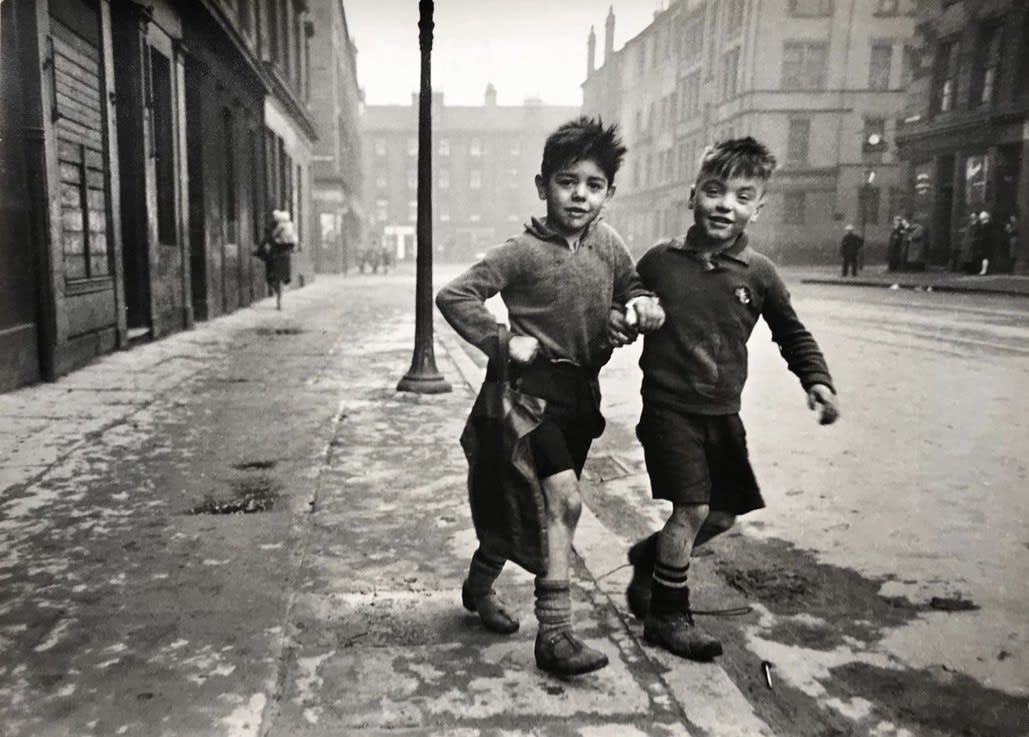Bert Hardy
Children of the Gorbals (Gorbal Boys), 1948
Vintage Gelatin Silver Print
26 x 36.3 cms
10 3/16 x 14 4/16 ins
10262
Exhibitions
Lives Less Ordinary. Working-Class Britain Re-seen, Two Temple Place (25th January 2025 – 20th April 2025)
Stamped on the verso with the artist's stamp and a Picture Post stamp. Also inscribed Gorbals and Children of the Gorbals Rare enlarged vintage print of Bert Hardy's most famous...
Stamped on the verso with the artist's stamp and a Picture Post stamp.
Also inscribed Gorbals and Children of the Gorbals
Rare enlarged vintage print of Bert Hardy's most famous image.
On 31 January 1948, the illustrated magazine, Picture Post, published an article about a working-class district of Glasgow which it described as 'The Forgotten Gorbals'. The article advocated urgent social reform and was accompanied by thirteen photographs, three by Bill Brandt and the rest by Bert Hardy. This image shows two young boys running to the local shop. It became one of Hardy's most iconic works, capturing childhood optimism beyond the poverty and squalor that most families experienced whilst crammed into the area's tenements.
This iconic image of friendship on the streets of the Gorbals, one of the poorest areas in Glasgow, Scotland, typifies Hardy's vision of hope amidst poverty.
The Gorbals was often referred to as Europe's worst slum, and as one of the most dangerous places in the UK but despite the poverty and crime, in this photograph Hardy identifies something more optimistic.
Hardy later recalled that Picture Post assigned this feature story on poverty in the Gorbals to Bill Brandt, but Hardy, who grew up in the poor streets of London's Blackfriars, claimed that he was better suited to record the story and so was also sent.
This particular image of two boys in Clelland Street was Hardy's favourite: poverty transcended by the playfulness of the children in a way that for Hardy also captured the spirit of his own difficult childhood. However, the magazine's editors chose not to publish it and instead selected grittier shots of Gorbals life. In a sense they were vindicated, for the published images by Hardy of vandalised housing and tattered curtains won him the inaugural Encyclopaedia Britannica Photographic Award. However, once the image of the two boys became known it swiftly became Hardy's most popular picture.
The boys' identities were unknown until 1985 when the Evening Times newspaper in Glasgow launched a campaign to trace them: Les Mason (the boy on the left) and George Davis (on the right) were reunited for the first time since primary school. At the time of the photograph in 1948, Mason and Davis, both aged seven, were running to the chemist on errands for Mason's mother. Davis died in 2002 and Mason in July 2011.
Also inscribed Gorbals and Children of the Gorbals
Rare enlarged vintage print of Bert Hardy's most famous image.
On 31 January 1948, the illustrated magazine, Picture Post, published an article about a working-class district of Glasgow which it described as 'The Forgotten Gorbals'. The article advocated urgent social reform and was accompanied by thirteen photographs, three by Bill Brandt and the rest by Bert Hardy. This image shows two young boys running to the local shop. It became one of Hardy's most iconic works, capturing childhood optimism beyond the poverty and squalor that most families experienced whilst crammed into the area's tenements.
This iconic image of friendship on the streets of the Gorbals, one of the poorest areas in Glasgow, Scotland, typifies Hardy's vision of hope amidst poverty.
The Gorbals was often referred to as Europe's worst slum, and as one of the most dangerous places in the UK but despite the poverty and crime, in this photograph Hardy identifies something more optimistic.
Hardy later recalled that Picture Post assigned this feature story on poverty in the Gorbals to Bill Brandt, but Hardy, who grew up in the poor streets of London's Blackfriars, claimed that he was better suited to record the story and so was also sent.
This particular image of two boys in Clelland Street was Hardy's favourite: poverty transcended by the playfulness of the children in a way that for Hardy also captured the spirit of his own difficult childhood. However, the magazine's editors chose not to publish it and instead selected grittier shots of Gorbals life. In a sense they were vindicated, for the published images by Hardy of vandalised housing and tattered curtains won him the inaugural Encyclopaedia Britannica Photographic Award. However, once the image of the two boys became known it swiftly became Hardy's most popular picture.
The boys' identities were unknown until 1985 when the Evening Times newspaper in Glasgow launched a campaign to trace them: Les Mason (the boy on the left) and George Davis (on the right) were reunited for the first time since primary school. At the time of the photograph in 1948, Mason and Davis, both aged seven, were running to the chemist on errands for Mason's mother. Davis died in 2002 and Mason in July 2011.
1
of
10



